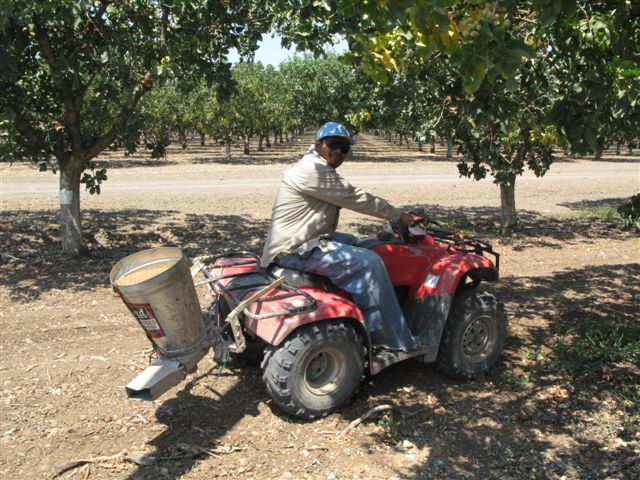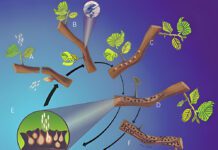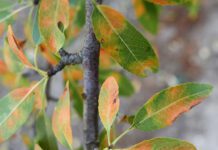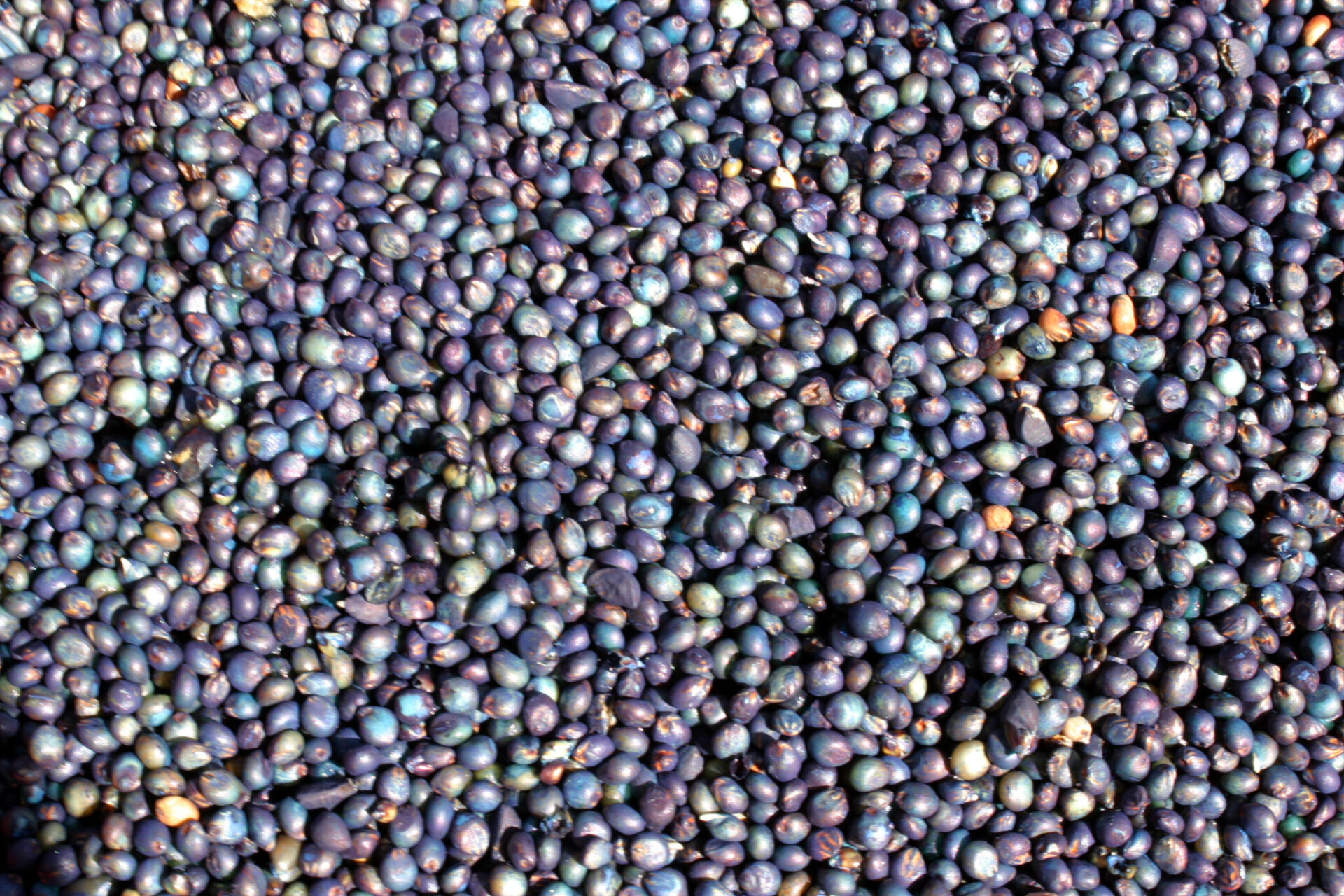
Reducing navel orangeworm damage in almond and pistachio orchards is one way of preventing aflatoxin contamination in the harvested crops.
Another component that is widely used in pistachio orchards and is gaining traction in the almond industry is the use of AF36, a sterilized sorghum product that carries spores of an atoxigenic strain of the fungus Aspergillus flavus. This fungus species occurs naturally in orchard soils and has both toxigenic and atoxigenic strains. The atoxigenic AF36, spread on orchard floors, displaces the toxigenic strains that can cause formation of aflatoxin when the nuts are damaged by navel orangeworm.
Since use of AF36 was approved by FDA in almonds in 2017, more almond growers are now applying this product in their orchards to reduce chances of aflatoxin contamination. The product has been available to pistachio growers since 2012 and nearly all pistachio acres are treated annually.
The reduction of aflatoxin is important to pistachio and almond growers because domestic and export markets will reject shipments if they exceed the tolerance level for aflatoxin. EU rejects at 10 parts per billion (ppb) and the U.S. rejection level is 15 ppb. Rejected shipments incur costs for resorting and testing, and in some cases may also be destroyed.
Encouraging Adoption
Themis Michailides, UCCE plant pathologist at the UC Kearney Agricultural Research and Extension Center and a lead researcher on the efficacy of AF36, has been conducting research on AF36 for the past eight years. Field studies in both pistachios and almonds achieved aflatoxin reduction of up to 45% in crop samples. Displacement rates in the soil reached 90 to 95%.
In his research, Michailides said effectiveness of AF36 is measured by the displacement of the toxigenic strains and also by the lower frequency of rejected loads in export markets.
In pistachios, application of AF36 in orchards is recommended every year, usually mid-July to mid-August. In almonds, Michailides’ research showed that the first year it is applied in an orchard, the biocontrol strain reaches very high levels and can survive for a second year in high levels. Research suggests AF36 is more effective when used every year as it helps build up the population in the soil. Michailides said if applications ceased, it is likely that the competitive effect would diminish. Nearly all California pistachio acres are treated annually with AF36, said Bob Klein, manager of the California Pistachio Research Board, due to subsidies from processors.
Michailides is continuing several research projects, partially funded by the Almond Board, to further establish the efficacy of AF36.
“My ultimate goal is for almond growers to adopt this method of aflatoxin control as well as the pistachio growers have,” he said.
ABC’s Associate Director of Food Research & Technology, Guangwei Huang, confirmed adoption of AF36 by almond growers is increasing. He is working on improving the efficiency of the product as well as an incentive program to promote use.
AF36 is marketed under the trade name “AF36 Prevail”. It is produced by the Arizona Cotton Research and Protection Council, a non-profit state agency that was originally formed to develop the product for cotton growers.
Leighton Liesner, executive director of the agency said other commodities, including walnuts, have sought to be included on the AF36 label. Liesner said he has been in contact with the California Walnut Board about adding a registration. The Environmental Protection Agency chooses to label AF36 as a biopesticide, Liesner said, and compliance with Federal Insecticide, Fungicide and Rodenticide Act (FIFRA) is necessary.
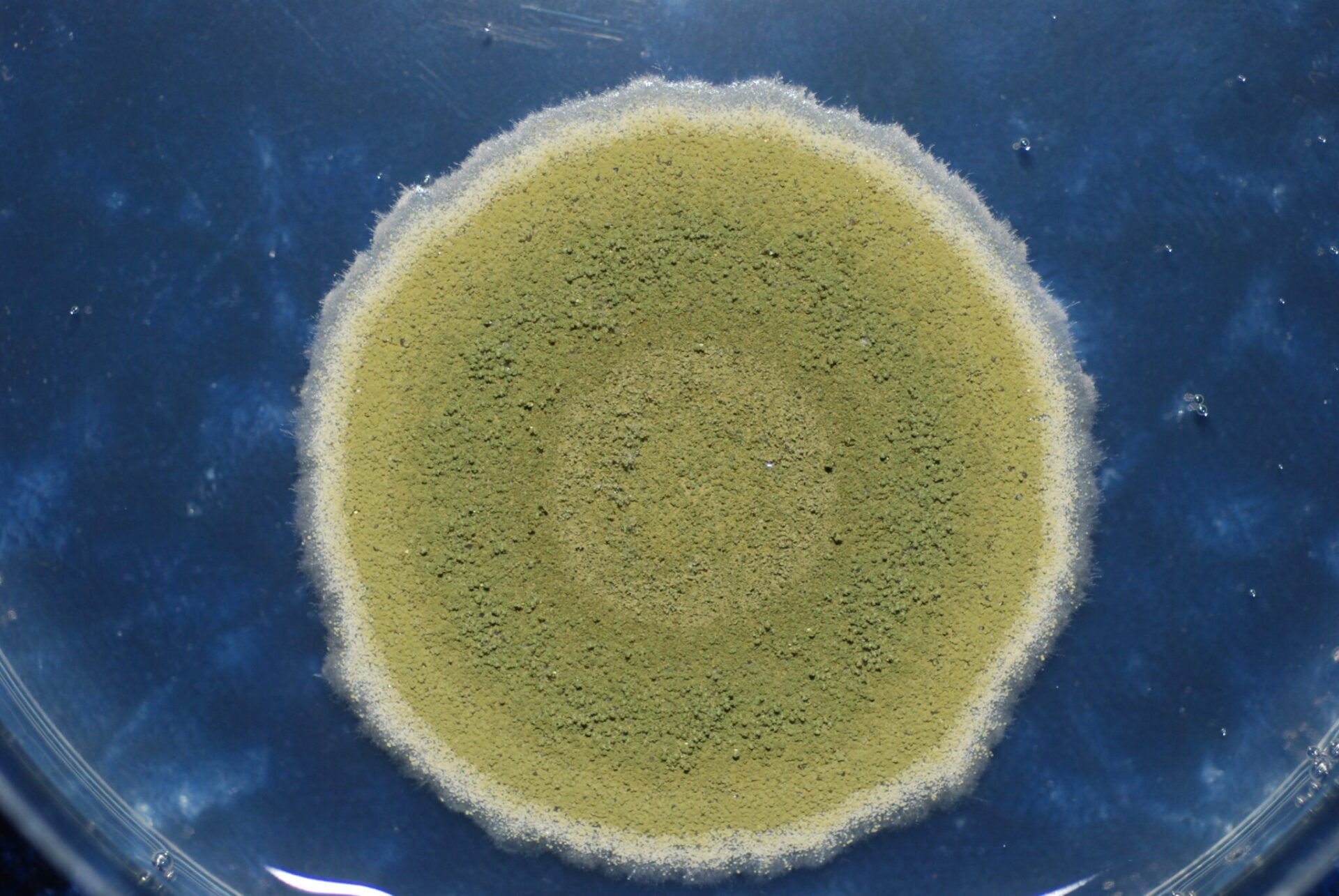
How it Works
To make the product, sterilized sorghum seeds are treated with a commercial coating technique to hold the fungus spores. The spores are from genetically isolated sterilized cultures. Liesner said that soil sampling to show growers the levels of the atoxigenic strains in their orchard soils is done for free to producer cooperators including American Pistachio Growers Association.
Jeff Chedester of Western Milling, a distributor for AF36 in California, said retail prices for the product can vary; a ballpark figure is less than $10 an acre plus application costs.
In 2017, the first year AF36 was available for use in almonds, US EPA approval came too late in the season to apply the product. Last year, more almond growers became aware of AF36 and began applications. Liesner said growers are realizing that an area-wide approach to displacing toxic strains will be more effective in the long run.
Michailides’ research has also focused on optimum application methods for AF36. In almonds, the best time to apply is about two weeks before hull split, usually in mid-July, to ensure maximum sporulation of the atoxigenic A. flavus strain. It should be applied on the wet zone of the orchard floor at the rate of 10 pounds per acre. Growers report using an ant bait spreader or a pair of spreaders at each side pulled by an ATV or a tractor works well. After application, irrigation is necessary to encourage sporulation. AF36 should only be spread where water can reach it. In some instances, growers pre-irrigate to have a moist soil before application of AF36.
If orchard conditions are optimal for sporulation, the spores of the biocontrol strain will disperse throughout the orchard and into tree canopies. This dispersal increases the potential to displace the toxigenic strains and decreases the potential for aflatoxin contamination. Michailides noted that his future research would focus on application strategies to deliver AF36 to the orchard environment in a timely manner even when conditions for sporulation are less than optimal. New formulations and timing of application will also be researched.
Although AF36 Prevail® is the only AF36 product currently registered by the EPA, another biological control currently on the market for aflatoxin control is Afla-Guard GR, created by Syngenta. This product uses barley instead of sorghum (as is used by AF36 Prevail®) as the sterile seed carrier for a different atoxigenic fungal strain and appears to sporulate better under drier and cooler conditions. It has been registered for use with peanuts and corn, and Michailides and researcher Dr. Ramon Jaime expect it could be approved for use on almonds, figs and pistachios by 2021.
